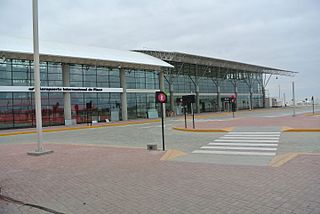Cap. FAP José A. Quiñones González International Airport | |||||||||||
|---|---|---|---|---|---|---|---|---|---|---|---|
| Summary | |||||||||||
| Airport type | Public | ||||||||||
| Operator | ADP | ||||||||||
| Location | Chiclayo | ||||||||||
| Elevation AMSL | 97 ft / 30 m | ||||||||||
| Coordinates | 6°47′15″S79°49′40″W / 6.78750°S 79.82778°W Coordinates: 6°47′15″S79°49′40″W / 6.78750°S 79.82778°W | ||||||||||
| Map | |||||||||||
| Runways | |||||||||||
| |||||||||||
Capitán FAP José A. Quiñones González International Airport( IATA : CIX, ICAO : SPHI) is an airport serving Chiclayo, Peru and the surrounding metropolitan area. It is run by ADP a private airport operator that operates various airports in northern Peru. It is the main airport of the Lambayeque Region, one of the most populous regions of Peru.
An IATA airport code, also known as an IATA location identifier, IATA station code or simply a location identifier, is a three-letter code designating many airports around the world, defined by the International Air Transport Association (IATA). The characters prominently displayed on baggage tags attached at airport check-in desks are an example of a way these codes are used.

The ICAOairport code or location indicator is a four-letter code designating aerodromes around the world. These codes, as defined by the International Civil Aviation Organization and published in ICAO Document 7910: Location Indicators, are used by air traffic control and airline operations such as flight planning.

Chiclayo is the principal city of the Lambayeque region in northern Peru. It is located 13 kilometers inland from the Pacific coast and 770 kilometers from the nation's capital, Lima.
Contents
The Chiclayo VOR-DME (Ident: CLA) is 3.57 nautical miles (6.61 km) off the threshold of runway 19. The Chiclayo non-directional beacon (Ident: HIC) is located on the field. [3] [4]

A non-directional (radio) beacon (NDB) is a radio transmitter at a known location, used as an aviation or marine navigational aid. As the name implies, the signal transmitted does not include inherent directional information, in contrast to other navigational aids such as low frequency radio range, VHF omnidirectional range (VOR) and TACAN. NDB signals follow the curvature of the Earth, so they can be received at much greater distances at lower altitudes, a major advantage over VOR. However, NDB signals are also affected more by atmospheric conditions, mountainous terrain, coastal refraction and electrical storms, particularly at long range.
The airport is also used by the Peruvian Air Force. It hosts one of the Air Force's two air superiority/interceptor squadrons, Escuadrón Aéreo 612 (Fighter Squadron 612 "Fighting Cocks"). The blast shelters housing the squadron's Mig 29 aircraft are visible from the airport runways.

The Peruvian Air Force is the branch of the Peruvian Armed Forces tasked with defending the nation and its interests through the use of air power. Additional missions include assistance in safeguarding internal security, conducting disaster relief operations and participating in international peacekeeping operations.
The airport is named after Jose Quiñones Gonzalez, a FAP pilot who was killed during the Ecuadorian-Peruvian War of 1941.

José Abelardo Quiñones Gonzáles was a Peruvian military aviator and posthumously became a national hero in the Batalla de Zarumilla, during the Ecuadorian–Peruvian war, also known as the War of '41.

The Ecuadorian–Peruvian War, known locally as the War of '41, was a South American border war fought between 5–31 July 1941. It was the first of three military conflicts between Ecuador and Peru during the 20th century. During the war, Peru occupied the western Ecuadorian province of El Oro and parts of the Andean province of Loja. Although the Ecuadorian–Peruvian War occurred during World War II, it was not part of the conflict; Ecuador and Peru were neither affiliated with nor supported by the Allies or the Axis.








